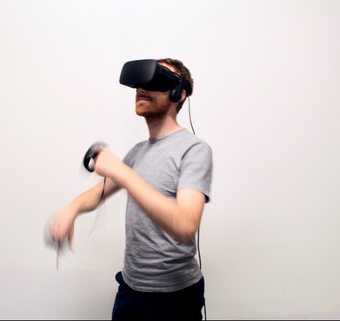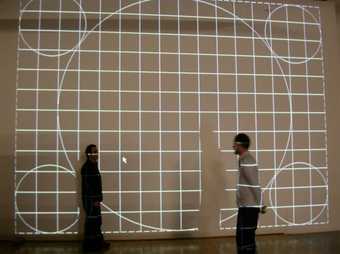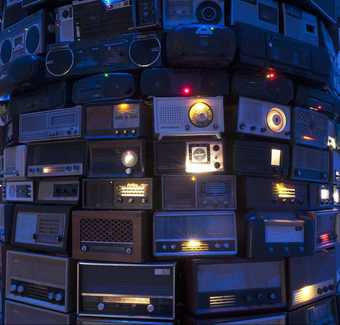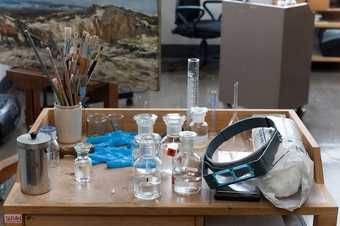
The Preserving Immersive Media project explores how to effectively care for artworks which use immersive technologies such as virtual reality headsets
Photo: Jack McConchie
Artists are increasingly engaging with immersive media such as 360 video, real-time 3D and virtual, augmented and mixed reality. The artworks they produce are beginning to enter the collections of cultural heritage institutions and, as a result, conservators must consider how they might be displayed in the future. Immersive media technologies present considerable challenges to our ability to stabilise and preserve: they consist of complex systems of interlinked components (many of which are proprietary and closed-source) and are dependent on the continued support of a rapidly moving, innovation focused industry.
Building on their existing expertise in the conservation of technology dependent artworks, Tate’s Time-based Media Conservation team are conducting a research project to build knowledge in this emerging area of practice. This project seeks to identify key risk factors in the long-term preservation of immersive media artworks and develop high-level guidelines for those creating and collecting them. The project team will interview a variety of artists in order to get a broader sense of the methods and tools used in the creation and display of these works, as well as strategies currently employed by makers.
Identifying Preservation Risks
The first phase of the project will examine the complex ecosystem of hardware and software involved in production and staging of immersive media artworks. This includes specialist Virtual Reality (VR) hardware such as headsets and tracking systems. A key requirement is to understand the defining characteristics of hardware components and the qualities they bring to an experience, alongside understanding connections with the supporting software environment. The aim is to better understand the impact of migrating to new hardware in the future. It will also be necessary to consider how open standards (such as OpenXR) could support flexible systems which might more easily respond to change in the future.
Using artwork case studies, the project will explore 360 video and real-time 3D software, including the potential value of acquiring production materials associated with the artworks such as project files, assets and source code. Works may show characteristics which are closely linked to the specific technologies employed that might tie the artwork to a period of history. In an industry that develops new technology at a rapid pace, the interests of a collecting institution can be seen to quickly diverge from notions of technological progress.
Exploring Preservation Strategies
The project will also explore the potential value of established preservation strategies from the field of digital preservation for supporting long-term access to immersive media. Emulation (and related techniques such as virtualisation) show potential as a means of enabling access to software designed to run on older platforms, although it is currently unclear how reliance on physical hardware may present barriers to its use. Alternatively, software might be incrementally updated in the short-term or migrated to new engines or platforms in the longer-term; the implications of this, both in terms of the resources required and the potential loss of important characteristics, must be carefully considered. In addition to considering how access to source materials will support such approaches, the project will consider the potential suitability of open file formats for preserving 3D assets and scenes independently of the tools with which they were produced.
Collaboration and Community Engagement
Making progress in meeting this significant challenge requires collaboration between creators, technologists and conservators. The Preserving Immersive Media Group (PIMG) has been formed to bring together interested parties from museums and industry who are working to share knowledge and move towards the establishment of best practices.
Project Outcomes
Preserving Virtual Reality Artworks Report
This report introduces virtual reality (VR) technologies and identifies the challenges artists and the cultural heritage sector face in achieving the long-term preservation of artworks which make use of them. This report is intended to inform those interested in the preservation of VR artworks, particularly time-based media conservators, as to the components they are likely to receive when acquiring VR artworks, their characteristics and dependencies, and their vulnerability in terms of long-term preservation. The report concludes with recommendations for artists and institutions who are dealing with the immediate problem of caring from VR artworks, and with recommendations for further research.
Acquisition Information Template
This document is designed to guide information gathering and discussion during the early stages of the acquisition of a virtual reality (VR) artwork, primarily with conservation and long-term preservation in mind. This is designed to be completed by or in close collaboration with an artist prior to receiving media from the artist.
Augmenting Our Approach to Preservation: Documentation of Experience for Immersive Media
Written by sasha arden during their 2021–22 graduate internship at Tate, this paper considers the experiential dimension of immersive media (IM) and its significant role in preservation and future access. Immersive media requires extensive documentation as part of preservation efforts. These go beyond existing methods of documentation for software-based and interactive works due to their technological complexity and rapid obsolescence cycles. A holistic approach is outlined, offering relevant techniques and considerations both from established interactive media preservation and from other disciplines that deal with experience. The process of creating documentation and how it may be used over time is also considered, advocating for decolonial ethics and open institutional practices to best serve IM works and their publics.
Project Information
Project Team
Jack McConchie, Time-based Media Conservator
Tom Ensom, Time-based Media Conservator
Louise Lawson, Conservation Manager, Time-based Media
This research has been supported by Lumen Art Projects Ltd.



